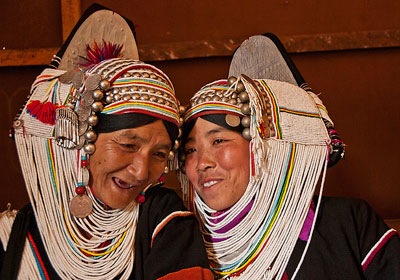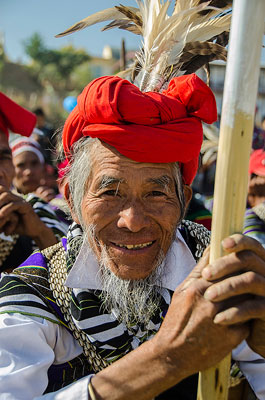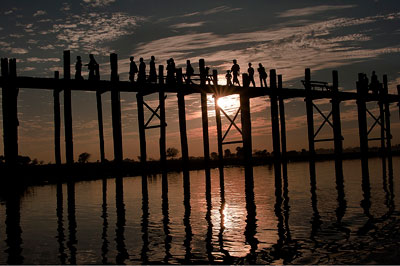Returning for more in Myanmar
This article appears on page 6 of the January 2014 issue.
by Susan Young; Los Angeles, CA
At the end of our December ’11 trip of 19 days, my husband, Fred, and I left Myanmar hungry for more of its sensuous beauty. We returned in February 2013 for a 14-day trip.
We again traveled with Win Kyaw Zan of Asia Photo Travels & Tours (Yangon, Myanmar; phone +95 9 5010501), the guide who had wonderfully spoiled us with his enthusiasm, amazing depth and breadth of knowledge, empathy, humor, flexibility and photographic help — all beyond compare.
The first time
Since sanctions against Myanmar have been lifted over the past couple of years, travel to this country has grown, and signs of development and change were everywhere. Costs had risen significantly since 2011, before the building boom.
On our first trip, we met Win in Yangon, where we visited its Shwedagon Pagoda, covered in solid gold plates and teaming with worshipers and golden Buddha statues.
We saw fascinating and colorful street markets before flying to Bagan, the site of magnificent pagodas dating from the 10th to the 13th centuries. In Bagan, our early-morning balloon ride was a fairy-tale experience, offering a view of pagodas bathed in the light of the rising sun.
The people — farmers driving ox carts and artisans plying their crafts on intricate handmade lacquerware — were friendly and happy to be photographed.
From Bagan, it was on to Mandalay and nearby Amarapura, an ancient Burmese capital, where the most photographed and world’s longest teak bridge (1.2 kilometers), the U Bein Bridge, invited photos of its stunning reflection at sunset.
Mandalay’s streets were crammed with workshops, where Buddha statues emerged from blocks of marble fashioned by carvers toiling in the dust-sodden air and thin gold leaves were pounded and sold to be applied by worshipers to Buddhas and pagodas.
We continued to the Shan State in the northeast, the area around Kyaingtong (Kengtung) where hill tribe people — the Akha, Palaung, Akhu and Eng — live, each with their distinctive dress and traditions.
At Inle Lake, fishermen, each with a single oar attached to one ankle, wound through currents and eddies holding large circular nets to catch fish. There the women wove magical textiles from lotus flower fibers, and elegant hand-wrought silver was created by men.
Padaung villages inhabited by women wearing neck rings, a fading tradition, were there as well. Monks in saffron robes and nuns in pink graced every view.
Our return
The power of this first trip called us back in 2013. Again met by the welcoming smile of Win, we began in Yangon and flew to Bagan the next day.
Two days later we traveled west by road to Mindat, home to many people of the Chin tribe. The tattooed faces of the women, a practice originally done to discourage kidnapping by other groups, were unique in design to each tribe. The young women are no longer tattooed, as it is painful and now illegal.
We trekked into a Chin village, Kyar Hto, from Mindat. We were welcomed, but the village was engaged in preparations for the ritual that follows a death, which had occurred in the small bamboo home next to the chief’s house, where we had our homestay. It was an all-night affair of chanting, cooking and eating while building the coffin from the wood of the deceased man’s house.
Our return to Mindat brought us to a Chin festival where men, women and children, dressed in traditional clothes, performed dances.
From Mindat we drove back to Bagan, then flew to Yangon to start the second part of our trip. Driving to the south, we stopped at Pa-An and explored three sets of caves (Kaw Goon, Maha Sadam and Yathei Pyan) with hundreds of gilded images of Buddha dating back to the seventh century carved into the stone high on the cave walls.
Moving farther south to Mawlamyaing, we saw the world’s largest reclining Buddha and a rubber plantation with workers ironing out huge sheets of rubber by hand.
We continued on to the Golden Rock, one of the holiest shrines in Myanmar. This precariously tipped monolith, covered in gold leaf applied over centuries by worshipers, is, according to legend, held in place by a single hair of the Buddha enshrined in the stupa on top of the rock.
Back on the road, we drove north to Yangon, visiting along the way the poignant WWII cemetery where the Rangoon Memorial contains the names of 27,000 young Commonwealth soldiers who died in Burma.
Our next stop was Hinthagone Pagoda, where we saw a very special nat spirit dance, performed by men dressed and adorned as female spirits and accompanied by musicians playing traditional Burmese instruments. This dance is done to dispel bad spirits and ensure positive outcomes for those with illness, for crops and for overall well-being.
Back in Yangon, we bid farewell to the Shwedagon Pagoda at twilight before our departure.
This was, even for the second time, a trip of a lifetime.
The details
This private trip for the two of us cost $6,500 each and included all meals, hotels, tips, transportation in a 4x4 vehicle with an expert driver and all in-country flights. The only additional money we spent was for our purchases of glorious, unique handicrafts.
The hotels all were good to excellent and were the best available in each area.
The food was delicious, except during the village stay, which was expected and easily accommodated with the power bars from our packs. Burmese cooking is an amalgam of Thai, Chinese and Indian cuisines, with its own special elements — wonderfully yummy!
Our guide, Win, is a winner. He has led tours for many of our friends, and he guides photo tours accompanied by photo experts, all of whom sing his praises.
We are happy to share more of our experiences and photos; email us through ITN.




